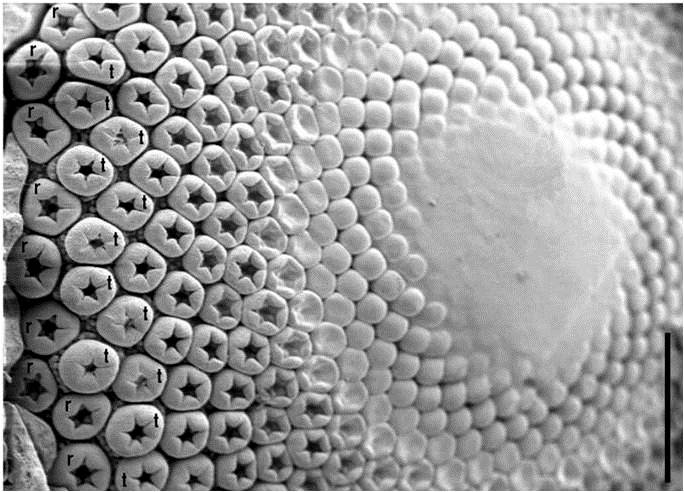
During the early stages of capitulum development small flower primordia are developing from the margins towards the center, forming left or right curving spirals (parastichies) that follow the Fibonacci numbers until the meristematic region (still undifferentiated in the figure) is fully packed and consumed.
What are the major factors and mechanisms that lead to formation of different types of flowers in a single genotype?
Recent studies have indicated a role for the conserved CYC/TB1-like TCP domain transcription factor genes in regulation of flower type identity. We have identified ten CYC/TB1 gene family members in gerbera that correspond to three gene clades specific to core eudicots. Our data indicates that especially the CYC2 clade genes are differentially expressed between the developing flower types being upregulated in ray flower primordia and are associated with inflorescence development. Functional analysis in transgenic gerbera indicates that GhCYC2, GhCYC3 and GhCYC4 act redundantly to regulate ray flower identity as ectopic expression these genes converts disc flowers into ray-like. Additionally, these genes show late functions during ray flower petal growth by affecting cell proliferation until the final size and shape of the petals is reached. Our data show functional diversification for the GhCYC5 gene. Ectopic activation of GhCYC5 increases flower density in the inflorescence, suggesting that GhCYC5 may promote the flower initiation rate during expansion of the capitulum.Our general aim is to understand how TCP gene family has evolved and functionally differentiated in Asteraceae as well as to characterize the molecular network (coregulators, target genes, upstream regulatory elements) connected to them.
PUBLICATIONS
- Laitinen et al., BMC Plant Biology 6: 11 (2006), http://dx.doi.org/10.1186/1471-2229-6-11
- Broholm et al., PNAS 105: 9117-9122 (2008), http://dx.doi.org/10.1073/pnas.0801359105
- Broholm 2009, The role of MADS and TCP transcription factors in Gerbera hybrida flower development, thesis
- Tähtiharju et al., Mol. Biol. Evol. 29: 1155-1166 (2012), http://dx.doi.org/10.1093/molbev/msr283
- Juntheikki-Palovaara et al., Plant J.79: 783-796 (2014), http://dx.doi.org/10.1111/tpj.12583
